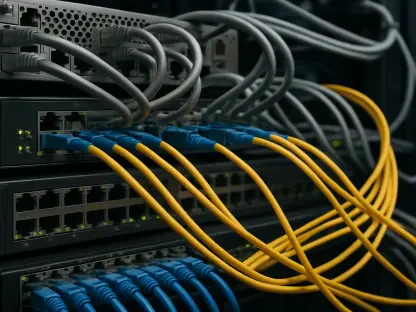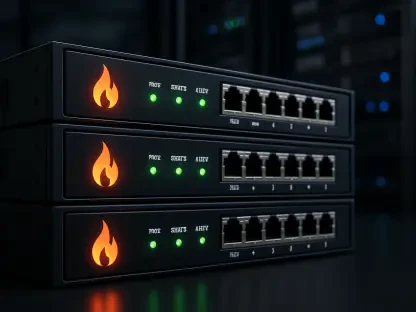In an era where digital connectivity defines progress, the 5G Standalone (SA) Core Network Market stands as a transformative force, breaking free from the constraints of hybrid 4G-5G systems to establish a fully independent 5G framework. This shift promises not just faster speeds, but a complete overhaul of how networks operate, introducing capabilities like ultra-low latency, unparalleled reliability, and innovative features such as network slicing. With industries racing to embrace digital transformation, the significance of a robust 5G SA core becomes undeniable, serving as the backbone for everything from smart cities to industrial automation. A recent industry forecast paints an astonishing picture of growth, estimating the market to soar from $7.95 billion in 2025 to a staggering $45 billion by 2035, reflecting a compound annual growth rate (CAGR) of 19.0%. This trajectory signals a profound change in data management and connectivity, poised to redefine communication and operational efficiency across global economies.
Forces Behind the Market Surge
The meteoric rise of the 5G SA Core Network Market is propelled by a confluence of powerful dynamics shaping the telecommunications landscape. At the heart of this expansion lies the unprecedented surge in data traffic, driven by the ever-growing number of connected devices and bandwidth-intensive applications like high-definition streaming and online gaming. Telecom operators are compelled to pivot toward standalone 5G networks to meet these demands, ensuring seamless performance and minimal delays. Beyond consumer needs, the urgency to support critical industrial applications further accelerates investment in SA infrastructure. This momentum is bolstered by the inherent advantages of 5G SA, which offers a native environment capable of handling complex, data-heavy ecosystems without leaning on outdated 4G LTE frameworks. Such capabilities position the market as a cornerstone of modern connectivity, addressing both current demands and future scalability with remarkable efficiency.
Another pivotal force driving this market is the increasing adoption of cloud-native architectures, which bring unmatched flexibility and speed to network deployment. Unlike traditional systems, these architectures allow for rapid service rollouts and dynamic scaling, catering to the diverse needs of a digital economy. Governments worldwide are also fueling this growth through policies and initiatives aimed at advancing digital infrastructure, recognizing 5G SA as a catalyst for economic progress. The rise of private 5G networks, particularly in sectors like manufacturing and healthcare, adds another layer of demand, as businesses seek dedicated systems for secure, real-time operations. This blend of technological innovation, policy support, and industry-specific requirements creates a robust foundation for the market’s projected climb to $45 billion by 2035, underscoring its role in shaping the future of global connectivity.
Innovations Defining the Market’s Path
A wave of groundbreaking trends is steering the 5G SA Core Network Market toward a future of enhanced efficiency and adaptability. Central to this evolution is the widespread embrace of cloud-native and software-defined networking solutions, which streamline operations by automating processes and reducing costs. These technologies enable telecom operators to manage vast networks with greater precision, ensuring optimal performance even under heavy loads. Additionally, the integration of artificial intelligence (AI) and machine learning (ML) into core networks marks a significant leap forward, allowing for predictive maintenance and intelligent resource allocation. Such advancements minimize downtime and enhance user experience, setting a new standard for network reliability. As these innovations converge, they pave the way for a more responsive and cost-effective infrastructure, aligning perfectly with the market’s rapid growth trajectory.
Equally transformative is the role of network slicing, a hallmark of 5G SA that permits the creation of customized virtual networks tailored to specific applications, from industrial Internet of Things (IoT) to public safety systems. This capability ensures that diverse needs are met without compromising performance, offering a level of personalization previously unattainable. Complementing this is the rise of edge computing and multi-access edge networks (MEC), which bring data processing closer to end users, slashing latency to support real-time applications like autonomous vehicles and augmented reality. These developments highlight an industry consensus on building user-centric networks that prioritize speed and flexibility. Together, these trends not only reinforce the market’s growth potential but also position 5G SA as the linchpin of next-generation connectivity, capable of addressing the complex demands of an increasingly digital world.
Global Adoption and Regional Variations
The global landscape of the 5G SA Core Network Market reveals a tapestry of adoption rates and investment priorities shaped by regional strengths and challenges. Leading the charge is the Asia-Pacific region, where nations like China, South Korea, and Japan are making substantial investments in 5G infrastructure to drive advancements in industrial automation and digital ecosystems. This aggressive push reflects a commitment to technological dominance, with SA networks serving as the foundation for smart manufacturing and connected urban environments. The region’s focus on large-scale deployments and innovation sets a benchmark for others, contributing significantly to the market’s projected growth to $45 billion by 2035. As these countries continue to refine their 5G capabilities, their influence on global standards and practices becomes increasingly pronounced, shaping the market’s direction.
In contrast, North America, particularly the United States and Canada, emphasizes practical applications through private 5G deployments tailored for enterprise connectivity and public safety. This approach highlights a strategic focus on leveraging SA networks for specific, high-impact use cases, ensuring both security and efficiency. Europe, meanwhile, pursues a balanced strategy, prioritizing energy-efficient and sustainable 5G solutions through collaborative initiatives funded by the European Union. Emerging markets in the Middle East, Africa, and Latin America are also entering the fray, albeit at a slower pace, with efforts centered on enhancing mobile broadband and enabling smart city projects. Despite varying economic and infrastructural constraints, a shared vision of improved connectivity unites these regions, illustrating the universal appeal of 5G SA technology and its potential to bridge digital divides while fostering innovation on a global scale.
Challenges and Opportunities Ahead
While the outlook for the 5G SA Core Network Market remains overwhelmingly positive, several obstacles could temper its rapid ascent if left unaddressed. High capital costs associated with full-scale SA deployment present a formidable barrier, especially for smaller telecom operators grappling with limited budgets. Integration with legacy systems adds another layer of complexity, often requiring significant overhauls that strain resources. Furthermore, a shortage of skilled professionals adept in 5G core technologies hampers progress, as does the looming concern over security and privacy in virtualized environments handling vast data volumes. These issues are compounded by interoperability challenges between equipment from different vendors and inconsistent regulatory frameworks across regions. Navigating this intricate web of financial, technical, and policy hurdles will be essential to maintaining the market’s momentum and realizing its full potential over the coming decade.
On the flip side, the market brims with opportunities that promise to offset these challenges and fuel further innovation. Industries such as automotive, energy, and healthcare are increasingly turning to private 5G networks to enable automation and real-time operations, creating a surge in demand for robust SA infrastructure. Emerging applications like metaverse platforms, extended reality (XR), and smart logistics showcase the versatility of 5G SA, opening new avenues for growth. The integration of AI-driven orchestration and edge-native computing is set to enhance operational efficiencies, while open network architectures encourage collaboration and innovation. As global investments in 5G SA technology intensify, the market stands ready to redefine connectivity, offering industries a platform to achieve unprecedented interactivity and productivity. Capitalizing on these prospects will be key to overcoming existing barriers and cementing the market’s transformative impact.
Reflecting on a Connected Legacy
Looking back, the journey of the 5G Standalone Core Network Market unfolded as a testament to human ingenuity and the relentless pursuit of better connectivity. What began as a vision to transcend the limitations of hybrid networks evolved into a monumental shift, with market valuations climbing impressively by 2035. The challenges of high costs and technical complexities were met with innovative solutions, as industries and regions adapted to harness the power of ultra-low latency and network slicing. Reflecting on this period, it became clear that the market’s success stemmed from a collective resolve to address digital demands through cutting-edge technology. Moving forward, stakeholders are encouraged to focus on collaborative strategies, investing in skill development and standardized frameworks to sustain growth. Exploring partnerships for cost-sharing and prioritizing security enhancements will ensure that the legacy of 5G SA continues to inspire, paving the way for a future where connectivity knows no bounds.









